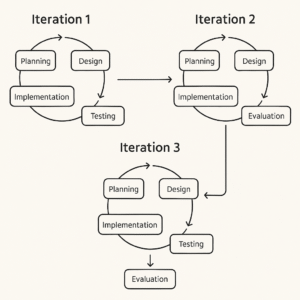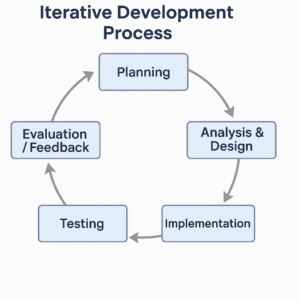Iterative Model
Definition:
The Iterative Model is a software development approach where the software is built step-by-step through repeated cycles (iterations). Each cycle involves planning, designing, building, and testing a part of the software.
Instead of building the entire software in one go, small parts (modules) are developed, tested, and improved continuously until the complete system is ready.
Phases of the Iterative Model:
Each iteration includes the following mini-phases:
-
Planning – Identify features for this cycle.
-
Analysis and Design – Plan how those features will work.
-
Implementation – Write code for selected features.
-
Testing – Check if the new part works correctly.
-
Evaluation – Review with the user and get feedback.
After feedback, the next iteration starts with improvements.
Features of the Iterative Model:
-
Software is developed in cycles.
-
Each cycle improves or adds more to the product.
-
User feedback is collected after every cycle.
-
Mistakes can be corrected early.
-
Results are available faster than in Waterfall.
Advantages of Iterative Model:
-
Easier to fix mistakes early.
-
User feedback improves quality.
-
Delivers working software earlier in the process.
-
Flexible for changes in requirements.
-
Easier to test small parts rather than a big project at once.
Disadvantages of Iterative Model:
-
More planning and managing are needed.
-
Not suitable for very small projects.
-
Repeating tests and design increases cost and time.
-
Requires good user communication after every cycle.
Phases of the Iterative Mode

1. Planning
What happens in this phase:
-
The development team and client decide which part or feature of the software to work on in the current iteration.
-
Goals are set for what should be achieved in this cycle.
-
A timeline and resources are allocated.
Why it’s important:
Good planning helps the team stay focused and complete tasks within time and budget.
2. Analysis and Design
What happens in this phase:
-
Based on the planned feature, the team analyzes how it should work.
-
A design is created showing how the user interface, database, or logic will be structured.
-
Tools like flowcharts, ER diagrams, or UML diagrams are used.
Why it’s important:
A clear design prevents confusion during coding and ensures the software is built correctly.
3. Implementation (Coding)
What happens in this phase:
-
Developers write the code for the features planned and designed in the current cycle.
-
Programming languages, frameworks, and tools are used as needed.
-
The module (or part of the software) is created and connected to previously developed modules.
Why it’s important:
This is where the software actually starts taking shape and becoming usable.
4. Testing
What happens in this phase:
-
The developed feature/module is tested for bugs, errors, or missing functionality.
-
Types of testing:
-
Unit testing (individual parts)
-
Integration testing (combined modules)
-
Functional testing (does it do what it should?)
-
Why it’s important:
Testing ensures that the software works properly and no errors go unnoticed.
5. Evaluation / Feedback
What happens in this phase:
-
The feature is shown to the client or end-user.
-
Feedback is collected on design, functionality, and performance.
-
The team discusses what worked well and what needs improvement.
Why it’s important:
User feedback helps correct issues early and ensures future iterations are better.
Best Use Case for Iterative Model:
-
When the requirements are not clear in the beginning.
-
For medium to large-scale software.
-
Projects where user feedback is important.
-
Examples:
-
Online shopping apps.
-
Educational platforms.
-
Social media websites.
-
